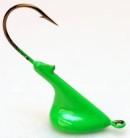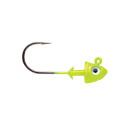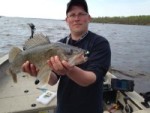When you’re targeting walleye, there are many different hooks, lures, and baits to choose from. From fancy crankbaits with photo-realistic patterns, to simple “hook, line and sinker” rigs. There is no doubt you can hook good numbers of walleye with any of those lures. But in this article for Canadian Fishing Forum, I will be writing about what I consider the most versatile of all choices. The good ol’ Jig!
There are many different styles of jigs. There’s Round heads, Walleye heads, swim-jig styles, Darter heads, Knuckle-ball jigs, etc. The list goes on and on. They are all unique. For the most part they all can be used in a vertical presentation, or a horizontal presentation. Some styles however are better suited for vertical jigging for walleye and bass then they are for casting. I’m going to talk about a few different styles of jigs, and how I like to use them.
The Basic Rule of Jigs
There is one basic rule of thumb when it comes to jigs. For the most part, you are going to want to use as light of a jig as possible to maintain good bottom contact and stay as vertical as possible. For me, it goes like this: 1’-10’ of water 1/16oz-1/8oz, 10’-20’ 1/8oz-1/4oz, 20’-30’ 1/4oz-5/8oz. This is for “still” water, as soon as you get into current situations like the Red River and/or the Winnipeg River, you are going to need to up the weight of the jig to stay vertical. In medium to high current situations, using a ½ or 5/8 ounce jig per 10’ of water is not uncommon.
The reason to stay as light as possible is simple, you don’t want the fish to feel the weight of the jig whenever possible. If you’ve ever seen underwater footage of Bass or Walleye “inhaling” a bait you will understand why you want to stay light! It is truly amazing how fast fish will spit the hook if there’s to much weight.
There are of course, exceptions to every rule, and I’ll touch on those in another write up!
One other thing I will touch on throughout this article is hook style and size, but I will keep that specific to the few jig head styles I will talk about.
The Round Head Jig
The Round head jig is most common jig style most anglers use. And for good reasons! It is very versatile. You can cast it, drag it, vertical jig it, and rip it. It is a do-all type of jig. Generally the Round Head jigs are almost always tipped with live or artificial baits and are a staple of walleye fishermen all over North America. They come in a variety of sizes ranging from 1/64 oz and up. For the majority of anglers who will be reading this, we’ll focus on 1/8-5/8 oz.

If you were to open up the jig box of most Canadian anglers, you most likely going to find an assortment of 1/8-5/8 oz Round Head jigs in a variety of different colors. There is a few reasons for this, first off, they are relatively inexpensive. Secondly, they work under a variety of conditions year round.
Round heads are great for fishing live or dead bait as well as artificial baits. They come in many different hook styles and sizes to suit almost every presentation. Northlands Fire-ball jig comes with a short shank, ideal for nose hooking minnows and leeches, and most have the option of adding a stinger hook or spinner blade by way of a second eye on the back of the jig. The Greenback Slammer jigs have a long shank 3X super strong hook. These are ideal for hooking large frozen shiners and larger live minnows, as well as being useful for fishing larger swimbaits. Lip Ripper Tackle Round Head jigs use either an Eagle claw Sickle style hook or a mustad 2X super strong hook. The sickles are great for fishing live bait and smaller artificial baits like power minnows and grubs. While the 2X are great for larger plastics and live or dead bait.
The Walleye Head Jig
The Walleye Head jig features a tapered minnow-like head. This jig is becoming more popular with Canadian walleye and bass anglers over the last few years. It’s great for both vertical jigging and casting. It’s one of the best performing jigs for rip jigging plastics! Because of the tapered design it sometimes lets you get away with a little less weight than the standard Round Head type jig in current situations. Recently at an event on the Red River, I was able to fish a ½ oz Lip Ripper Tackle Walleye Head jig vertical in the current, while my partner who was using a ½ oz Lip Ripper Tackle Round Head jig was having some difficulty staying vertical in the same current. For me was a learning experience I’m now passing on to you the reader.

Personally I love this style of jig for rip jigging plastics. They have a faster fall rate than Round Head jigs, which is something I look for in a ripping jig. However, this is a situation where I tend to fish a little heavier than needed. I’ll fish 3/8-1/2 oz in 10’ of water. I want to be able to fish fast, and I’m not looking for subtle bites. 99% of the time when rip jigging you set the hook on the next rip up. The Lip Ripper Tackle Walleye Heads with the 2X Mustad hooks are ideal for this style of fishing. You get rock solid hooksets. and you can put extra horsepower on the fish if you are fishing heavy cover for bass or walleye without worrying about bent or broken hooks!
The Walleye Head jig makes a great live bait jig as well, I like to use them when drifting or dragging jigs, they tend to snag a little less than a round head jig, and seem to pop out easier when snagged at times too!
The Stand-up Head Jig
Another Canadian staple is the Stand-up Head jig. These are a great choice for Canadian Walleye and Bass anglers alike. One of the most common ones is Fin-Tech’s Knuckleball Jig. They are available in weights ranging from 1/16-3/8 oz in the original series. They have a unique design and hook style making them versatile for Bass and Walleye fishing in open areas as well as in cover. The unique bend allows weedless rigging of plastics with ease!

I like Knuckleball jigs for dead sticking large live minnows on the bottom. I almost always use a 3/8 oz size. I like to keep a big live minnow pinned in one spot. If nose-hooked’ the minnow struggles to try to move the jig. Because of the design of the jig head, the hook rides at about a 45 degree angle to the bottom. This design is great for easy hookups when big walleye or Bass attack the minnow on the bottom!
Several other companies make stand up style jigs, such as Northland Tackles Stand Up fireball jig. Savage Gear makes a unique stand up jig aimed towards Bass anglers, but it looks like it could be used for the tactic I described above as well!
The Swimbait Head Jig
One of my favorite ways to fish bass and walleye is on big swimbaits. These big soft plastic baits require specialized jigs to provide the right balance and hooking abilities. While swimbait heads are offered in sizes down to ¼ oz, most guys are using 1/2-1 oz sizes with 5/0-7/0 super strong hooks. Owner makes the most popular swimbait head, using the 3X super strong saltwater jig hook in a bullet nose design. Big Hammer makes a Hammer Head jig to complement their Big Hammer swimbaits. Strike King makes a Squadron head in 1/8-1 oz sizes as well.

Picking the right head for the swimbait can be tricky. Trying to rig a 6” big hammer on a standard 3/8 round head is almost an effort in futility. But skewer that same 6” bait on a hammer head or bullethead jig with a 6/0 or bigger hook, you are in for some great fun catching Walleye, bass, pike and of course lake trout!
The jig can be the most versatile tool in your box! Take the time to ‘get away from the norm’ with them. Think outside the box and you’ll put more fish in the livewell and in your photo album! Good luck and tight lines!
About The Author
 Patty is an avid fisherman who also owns Lip Ripper Tackle. For more info on Jigs and jig styles, visit his profile in the forum.
Patty is an avid fisherman who also owns Lip Ripper Tackle. For more info on Jigs and jig styles, visit his profile in the forum.